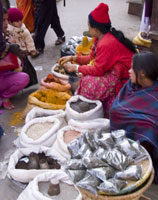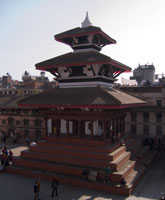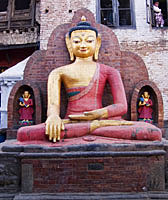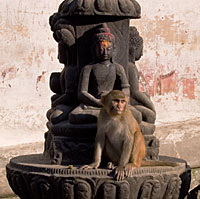Durbar Square Kathmandu
I flew into Katmandu around ten o’clock at night, which meant I unfortunately missed any view of the Himalayas. I spent most of the next day walking the streets of Thamel (the backpackers’ area of Katmandu) looking at the endless tables of vegetables, fruits, spices, and most omnipresently, curios of all kinds, statuettes of Buddha and Ganesh, tiny Buddhist prayer wheels, Gurkha knives and swords, wooden carvings of various gods, wooden flutes, endless stalls of wool hats, wool socks, and the nearly ubiquitous stores full of Pashmina shawls, scarves, bedcovers, sweaters and even dresses, most of which are probably 60% pashmina at best, but of course carry the full pashmina price tag.
 The Thamel area has been the center of tourist activity in Katmandu for so long now that it very much resembles a European city, complete with salami and butter sandwiches available in little garden cafes, which I had quite a few of during my stay in Paris. I suppose you could say that Thamel is the touristiest area I’ve been in yet, but that hasn’t really bothered me. There are all sort of western foods available, everything from tacos to great big pepper steaks. It’s a nice change to have a variety of culinary options, I will confess to being sick of Indian food. With the exception of a few nights here and there, I ate exclusively Indian food for 30 days. I don’t think I’ve ever eaten so much of one nationality’s cuisine in my entire life, so the change is nice. And from what I’ve read and heard from other travelers, Nepali food is nothing to get excited about (their chai is certainly lacking by Indian standards).
The Thamel area has been the center of tourist activity in Katmandu for so long now that it very much resembles a European city, complete with salami and butter sandwiches available in little garden cafes, which I had quite a few of during my stay in Paris. I suppose you could say that Thamel is the touristiest area I’ve been in yet, but that hasn’t really bothered me. There are all sort of western foods available, everything from tacos to great big pepper steaks. It’s a nice change to have a variety of culinary options, I will confess to being sick of Indian food. With the exception of a few nights here and there, I ate exclusively Indian food for 30 days. I don’t think I’ve ever eaten so much of one nationality’s cuisine in my entire life, so the change is nice. And from what I’ve read and heard from other travelers, Nepali food is nothing to get excited about (their chai is certainly lacking by Indian standards).
Nearly everything in Thamel is somehow geared to Nepal’s biggest tourist draw—trekking. Every other store on the streets is either a trekking guide company or sells knockoff trekking gear with fake US brand labels. The gear was particularly fascinating to me because I used to work at a North Face store in Costa Mesa and one of the things we were trained to do was spot fake gear that climbers brought back from expeditions. Whether the climbers were conscious of what they were doing or not depended on the individual, but invariably the cheap stuff they bought in Nepal fell apart and, by passing it off as genuine, would be covered by the North Face’s lifetime warranty. Most of the time it was pretty easy to spot fakes, telltale signs like terrible stitching or zippers that opened to nothing and existed only because the original had a pocket there, but some of the jackets and backpacks I saw on the streets of Katmandu were pretty good forgeries and it made me wonder if perhaps we missed a few things here and there when I worked at the North Face. There is one legitimate North face store somewhere in Thamel and though I have not been there, I was told that the prices are only marginally less than those in the US.
 After saturating myself with the streets of Thamel I went on a longer excursion down to Durbar Square (durbar means palace) to see the various pagodas, temples and the old palace. The palace itself no longer houses the King, but is still used for coronations and ceremonies and Durbar Square is still very much the hub of Katmandu. I haven’t talked to any Nepalis about it, but the King seems less than popular shall we say. The current King of Nepal came to power under rather bizarre circumstances and seems to be unpopular if the local English newspapers are to be believed. I arrived on International Human Rights day, which is an area where Nepal is, um, lacking. Along these lines I have added Amnesty International to the list of charities on the donations page.
After saturating myself with the streets of Thamel I went on a longer excursion down to Durbar Square (durbar means palace) to see the various pagodas, temples and the old palace. The palace itself no longer houses the King, but is still used for coronations and ceremonies and Durbar Square is still very much the hub of Katmandu. I haven’t talked to any Nepalis about it, but the King seems less than popular shall we say. The current King of Nepal came to power under rather bizarre circumstances and seems to be unpopular if the local English newspapers are to be believed. I arrived on International Human Rights day, which is an area where Nepal is, um, lacking. Along these lines I have added Amnesty International to the list of charities on the donations page.
Unfortunately most of the structures in the Durbar Square area were destroyed in a large earthquake in 1934 so, while much of the amazing teak woodwork was salvaged, the actual buildings are all relatively new. On my walk down to Durbar Square I passed hundreds of little shrines lurking in every corner of every streets; so many in fact that it was overwhelming and nearly impossible to keep track of even with my guidebook¹. I decided to hire a guide for a walking tour of Durbar Square itself with the hope that maybe that way I wouldn’t overlook anything. After skipping over the expensive and pushy guides near the entrance to the square, I managed to find one that was willing to work for cheap in exchange for an English lesson after my tour.
Each temple in the area is generally for a particular god and only a couple were actually open. I went in the Kumari Bahal which is The House of the Living Goddess and is, as the name implies, home to Kumari the living goddess reincarnated in the figure of a little girl. Every decade or so the Nepalis have to find the new Kumari through a process not unlike the way Tibetans find the next reincarnated Dalai Lama. Once found the young girl lives in Kumari Bahal until she reaches puberty at which point the goddess leaves her body and the search begins again. Presumably the girl then returns to her normal life though I didn’t actually get that part of the story.
Most of the other buildings and temples are only open on certain festival days, but you can go inside Kasthamandap (from which Katmandu takes its name) which began life as a community center for festivals and ceremonies and was only later turned into a temple for Gorakahnath. Originally built in the 11th century and supposedly constructed from a single tree, Kasthamadap, which means house of wood, was greatly rebuilt following the earthquake. Katmandu and Nepal in general has an interesting mixture of Hindu and Buddhist beliefs which also draw somewhat off of older tribal religions to create a wholly different sort of hybrid. Thus I also saw temples in a Muslim style with statues of Krishna inside and traditional Hindu gods with the head of Buddha.
The touristy aspect of Durbar Square is unfortunate and part of me spent much of my time wondering what Katmandu was like when the first mountaineers arrived overland from India, or even when the Beatles came and sat up on top of the temple. My guide claimed that many Nepalis thought for a while that these curious bleached skinned longhaired strangers must have come from space, which I didn’t really believe, but it must have been a strange site to see the Beatles sitting up on the temple steps smoking hash with the sadhus while throngs of Nepalis gathered to watch the incongruous strangers
After the tour we went to a little cafe and had some chai and I tried to help him understand the English verb “get, which is harder than it sounds, especially if one takes into account the number of idiomatic expressions that involve get. For instance “I’ll get you for that” or “how do I get to ______” none of which seems to translate very well to Nepali. I don’t know that I helped him all that much, but he seemed to pick up a few things and was satisfied enough to pay for the chai. The walk back to Thamel took me through what amounts to the garment district where I picked up a new hat and a pair of shoes which may well fall apart before I have a chance to wear them, but $3 US is hard to argue with.
I have slowly adjusting to the sight of my breath in the early morning chill of Katmandu’s unheated budget hotels. The nighttime temperatures drop near freezing, but, wrapped in a couple blankets and wearing my fleece jacket to bed, I have managed to stay comfortably warm through the night, though I have picked up a bit of a head cold probably due to the continuous and inescapable chill.
 In spite of an annoying nasal drip, the next day I set out for Swayambhunath, better known as the monkey temple. I was planning to walk, but about half way there a taxi driver convinced me to take a ride and after seeing the steps up to the main stupa I was glad I gave up the idea of walking. I entered the area from the back where a golden Buddha dominates the entrance to the monastery area and then walked over several smaller hills and then up to the main stupa. The stupa (the stupa being a sort of hemispherical Buddhist temple structure) is surrounded by numerous smaller shrines some in Buddhist styles and some in Hindu styles, which again illustrates the curious mix of religions in Nepal. The most interesting thing I saw was an inscription in Sanskrit which dates from the 12th century.
In spite of an annoying nasal drip, the next day I set out for Swayambhunath, better known as the monkey temple. I was planning to walk, but about half way there a taxi driver convinced me to take a ride and after seeing the steps up to the main stupa I was glad I gave up the idea of walking. I entered the area from the back where a golden Buddha dominates the entrance to the monastery area and then walked over several smaller hills and then up to the main stupa. The stupa (the stupa being a sort of hemispherical Buddhist temple structure) is surrounded by numerous smaller shrines some in Buddhist styles and some in Hindu styles, which again illustrates the curious mix of religions in Nepal. The most interesting thing I saw was an inscription in Sanskrit which dates from the 12th century.
 And yes there were indeed a number of monkeys in the temple grounds. The monkeys are considered holy because the monkey god once came to the aid of Shiva (at least I believe it was Shiva) when some bad monkey’s kidnapped one of his wives. I suppose it’s the curious nature of religious belief that the monkey who rescued her comes to symbolize all monkeys rather than those that kidnapped her. Had it gone the other way I suppose I would be able to dine on monkey some evening.
And yes there were indeed a number of monkeys in the temple grounds. The monkeys are considered holy because the monkey god once came to the aid of Shiva (at least I believe it was Shiva) when some bad monkey’s kidnapped one of his wives. I suppose it’s the curious nature of religious belief that the monkey who rescued her comes to symbolize all monkeys rather than those that kidnapped her. Had it gone the other way I suppose I would be able to dine on monkey some evening.
I have also been to Pashupatinath by the Bagmati River where the Hindus cremate the dead, but my experiences there were enough to warrant a full article so you’ll have to wait a day for that one at which point I will also upload some more pictures.
Thoughts?
Please leave a reply:
All comments are moderated, so you won’t see it right away. And please remember Kurt Vonnegut's rule: “god damn it, you’ve got to be kind.” You can use Markdown or HTML to format your comments. The allowed tags are
<b>, <i>, <em>, <strong>, <a>. To create a new paragraph hit return twice.